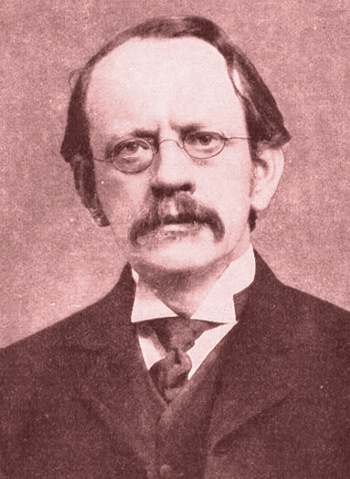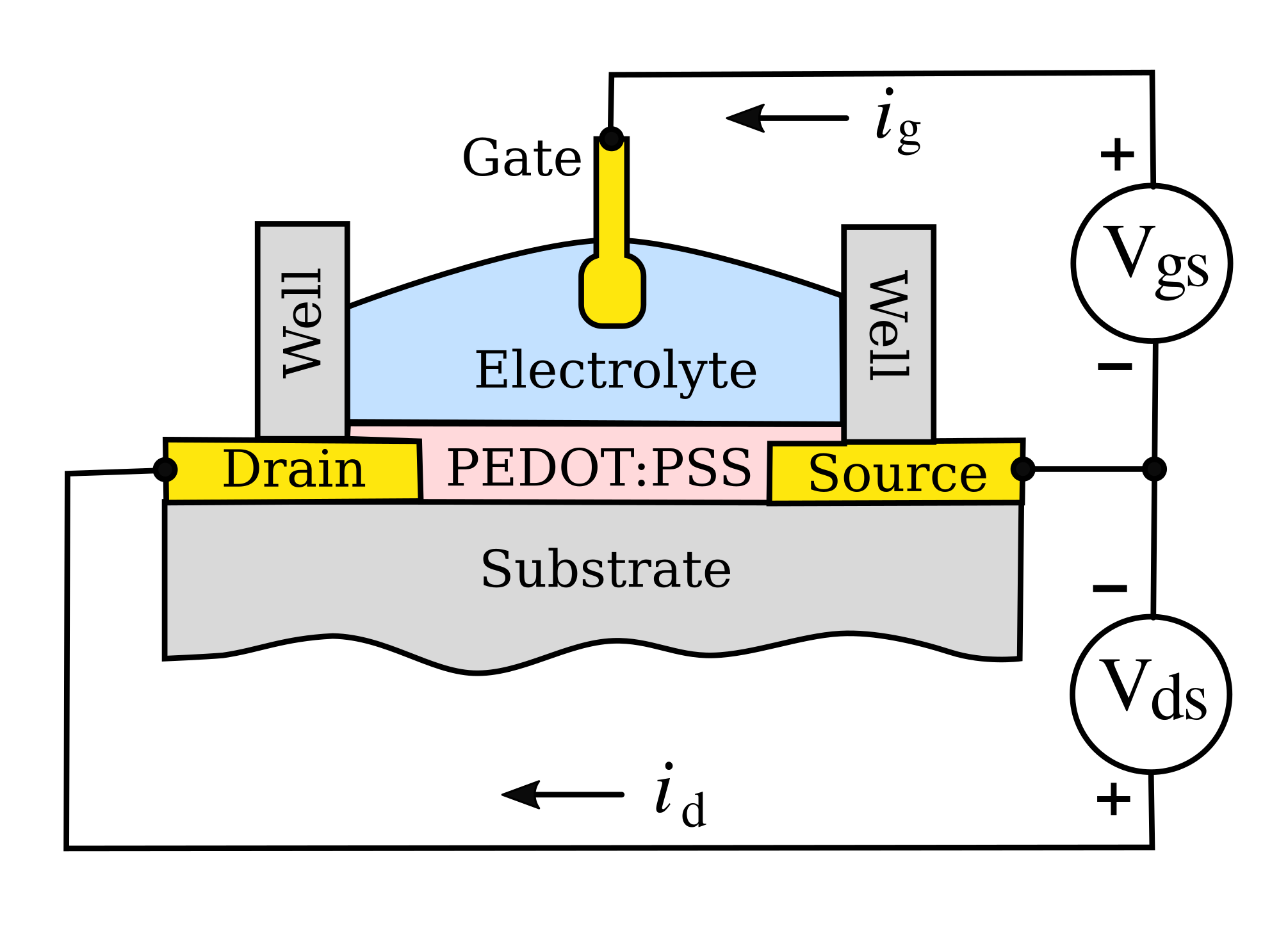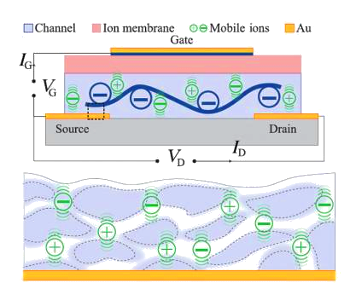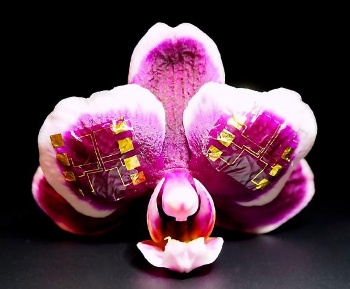Ion-Gated Transistors
July 1, 2019
While
electricity had proven itself useful for many prior years in
electrochemistry and in devices such as the
telegraph, the
electron was only discovered in 1897 by
Joseph John Thomson (1856-1940, commonly known as "J.J. Thomson"). For this discovery, Thomson was rather quickly awarded the 1906
Nobel Prize for Physics. Although Thomson's electrons were discovered as
cathode rays in
vacuum, his Nobel Prize
citation reads, "...for his
theoretical and
experimental investigations on the
conduction of electricity by
gases," primarily because he showed that electrons traveled farther in a gas than a larger
particle should.

J. J. Thomson (1856-1940).
In the later part of the 19th century, most scientists believed in the reasonable proposition that any constituent parts of atoms should also be of atomic size.
Thomson's experiments showed that the negatively-charged "corpuscles" he had discovered were a thousand times smaller.
Most importantly, he showed that electrons from all the atoms that he examined were that same.
The name for the negative charge carrier, electron, from the Greek word for amber (ηλεκτρον), was suggested earlier by George Stoney (1826-1911).
(Image via Wikimedia Commons, modified for artistic effect.)
The discovery of the electron answered some scientific questions and opened new avenues for
research, but it wasn't until the 1906
invention of the
triode vacuum tube by
Lee de Forest (1873-1961) that electrons enabled
electronic amplifier circuitry to advance
radio technology.
Vacuum tubes were used in the first
computers, including the
ENIAC, and they enabled most electronic devices through the
1950s.
Although the
transistor was invented in 1947, transistors were inferior to vacuum tubes for their first
decade. First of all, transistors were much more
expensive. Vacuum tube
manufacturing had become highly
automated by the
mid-20th century, while transistors were made from
germanium and
silicon crystalline materials that were expensive to grow. Early transistors were low
voltage, low
power, low
frequency devices, and they would operate over just a small
temperature range. Transistorized radios and
television receivers were a long time coming after the invention of the transistor.

My computer is bigger than your computer! From left to right, computer operators show component assemblies of vacuum tube computers: The 1956 ENIAC, which contained 20,000 vacuum tubes; the 1949 EDVAC, which contained nearly 6,000 vacuum tubes; the 1952 ORDVAC, built from 2178 vacuum tubes; and the 1962 BRLESC containing 1727 vacuum tubes, but also 853 transistors. (US Army photo 163-12-62, 1962, via Wikimedia Commons.)
Transistor technology has advanced to the point at which transistors on modern
integrated circuits are
built on a patch that's just
fifteen nanometers on a side. A silicon atom has a diameter of 0.222
nanometers, so you would think that there's still
plenty of room at the bottom. However,
quantum mechanical tunneling will prevent adequate transistor functioning somewhere below
5 nanometers.
When
speed is not important, we can change our focus from just electrons to their
positively-charged counterparts,
ions. In an
organic electrochemical transistor, the electron
current between a
source and
drain electrode is
modulated by ions that are injected into an
organic semiconductor (typically
PEDOT:PSS) in the narrow
channel region between them, the channel being immersed in an
electrolyte.
The ion
concentration in the channel region is controlled by application of a voltage to a
gate electrode, so the transistor is
analogous to a conventional
field-effect transistor. Since crystalline silicon is not needed in their fabrication, organic electrochemical transistor are suitable for large-area and low-cost electronic applications. These transistors are especially suitable for
biosensing applications, since they can work in an
aqueous environment with the electrolyte in
chemical communication with the
environment through a
permeable membrane.

A PEDOT:PSS organic electrochemical transistor.
These operate in the depletion mode, as shown by the voltage biasing on the gate; and, unlike MOSFETs, the gate does draw some current.
(Created using Inkscape. Click for larger image.)
The response time of such transistors is typically slow, but a team of
scientists and
engineers from
Columbia University (New York, New York) and
Columbia University Medical Center (New York, New York) has recently developed a
biocompatible electrochemical transistor that's fast enough to sense and and stimulate
brain cells.[1-3] Details of their device are
published in an
open access article in
Science Advances.[1] The research team was led by
Dion Khodagholy, an assistant professor of
Electrical Engineering at Columbia.[2]
Quite a few
criteria must be met for
safe and
efficient operation of transistors in
biological environments.[1] Foremost is biocompatibility, followed by
mechanical match with
tissue, and high speed operation at sufficient
amplification of low-amplitude
signals.[1] Conventional field-effect transistors made from organic semiconductors fulfill many of these criteria, but they must be encapsulated to avoid contact with
body fluids to allow proper device operation and eliminate
toxic discharge.[1] The encapsulation makes these devices bulky and
rigid.[2]

Schematic diagram of the Columbia University ionic channel transistor in cross-section.
The biasing voltages and associated currents are shown.
D-sorbitol creates an ion reservoir in which mobile ions (green) can travel within the channel.
(Columbia Engineering diagram by George Spyropoulos.)
Organic electrochemical transistor fulfill all the requirements except for speed.[2] The Columbia research team solved the speed problem by modifying the channel material to have its own mobile ions.[2] These mobile ions embedded in the channel's
conductive polymer create a self-(de)
doping process that eliminates the need for
ion exchange from an external electrolyte.[1] This shortens the travel distance of the ions and increases the transistor speed by an
order of magnitude.[2] Says Khodagholy,
"Importantly, we only used completely biocompatible material to create this device. Our secret ingredient is D-sorbitol, or sugar... Sugar molecules attract water molecules and not only help the transistor channel to stay hydrated, but also help the ions travel more easily and quickly within the channel... Our transistor's channel is made out of fully biocompatible materials and can interact with both ions and electrons, making communication with neural signals of the body more efficient."[2]
The reported response time of these transistors is 2.6 μs. As a test, the Columbia team did
electroencephalography, recording
human brain waves from the surface of the
scalp with a device small enough that it fit between
hair follicles to simplify placement.[2] Since these devices conformed to the scalp, chemical
adhesives were not needed.[1-2] These devices would be suitable, also, for the detection of signals involved with
heart,
muscle, and
eye movement.[2] The
authors speculate that integrated circuits of these transistors could be used as
implantable closed loop devices, as for the treatment of
epilepsy.[2]

NAND and NOR logic gates created with the Columbia University ionic channel transistor on a substrate conforming to the surface of orchid petals.
(Columbia University Irving Medical Center photograph by Jennifer Gelinas.)
![]()
References:
- George D. Spyropoulos, Jennifer N. Gelinas, and Dion Khodagholy, "Internal ion-gated organic electrochemical transistor: A building block for integrated bioelectronics," Science Advances, vol. 5, no. 2 (February 27, 2019), DOI: 10.1126/sciadv.aau7378. This is an open access article with a PDF file here.
- Holly Evarts, "Fast, Flexible Ionic Transistors for Bioelectronic Devices, Columbia University Press Release, February 27, 2019.
- Internal Ion-Gated Organic Electrochemical Transistor, Columbia Engineering YouTube Video, February 28, 2019.
Linked Keywords: Electricity; electrochemistry; electrical telegraph; electron; Joseph John Thomson; Nobel Prize for Physics; cathode ray; vacuum; citation; theory; theoretical; experiment; experimental; electrical conductance; conduction; gas; elementary particle; J. J. Thomson (1856-1940); 19th century; scientist; conjecture; proposition; atom; atomic radius; atomic size; electrical polarity; negative; electric charge; amber; George Stoney (1826-1911); Wikimedia Commons; research; invention; audion; triode; vacuum tube; Lee de Forest (1873-1961); electronic; amplifier; electronic circuit; circuitry; radio; technology; computer; ENIAC; 1950s; transistor; decade; cost; expense; manufacturing; automation; automated; mid-20th century; germanium; silicon; crystal; crystalline; material; voltage; electric power; frequency; temperature; television set; television receiver; technician; operator; electronic component; vacuum tube computer; EDVAC; ORDVAC; BRLESC; integrated circuit; semiconductor device fabrication; 10 nanometer process; nanometer; plenty of room at the bottom; quantum mechanical tunneling; 5 nanometer process; speed; ion; organic electrochemical transistor; electric current; source; drain; electrode; modulation; modulate; organic semiconductor; PEDOT:PSS; channel; electrolyte; concentration; gate; analogy; analogous; field-effect transistor; biosensor; biosensing; aqueous solution; chemical; environment; permeable membrane; depletion mode; bias voltage; MOSFET; Inkscape; engineer; Columbia University (New York, New York); Columbia University Medical Center (New York, New York); biocompatibility; biocompatible; neuron; brain cell; scientific literature; publish; open access article; Science Advances; Dion Khodagholy; Electrical Engineering at Columbia University; criterion; criteria; safety; safe; energy conversion efficiency; efficient; biological environment; mechanics">mechanical; tissue; amplifier; amplification; signal; body fluid; toxicity; toxic; stiffness; rigid; schematic diagram; ion; ionic; cross-section; D-sorbitol; reservoir; George Spyropoulos; conductive polymer; doping (semiconductor); ion exchange; order of magnitude; molecule; water; hydrate; hydrated; electroencephalography; human; neural oscillation; brain wave; scalp; hair follicle; adhesive; heart; muscle; eye; author; implant (medicine); implantable; feedback; closed loop; epilepsy; NAND gate; NOR gate; logic gate; wafer (electronics); substrate; Orchidaceae; orchid; petal.